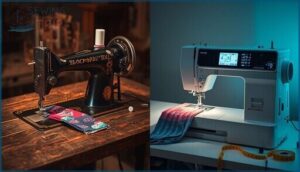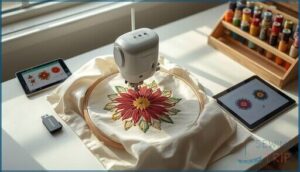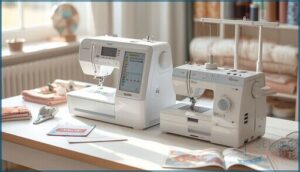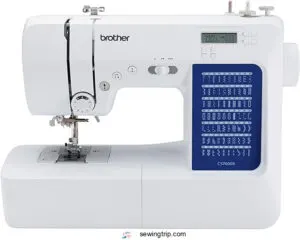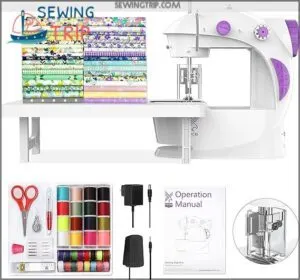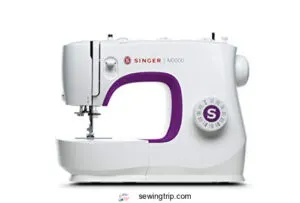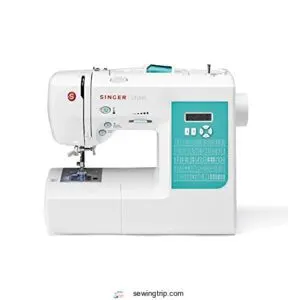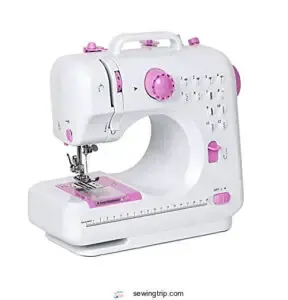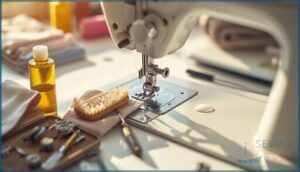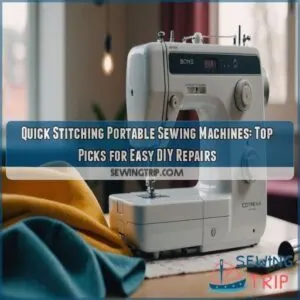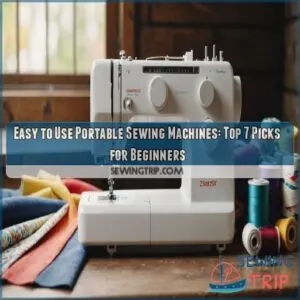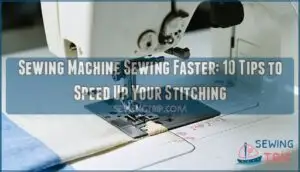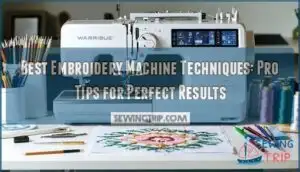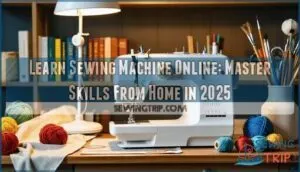This site is supported by our readers. We may earn a commission, at no cost to you, if you purchase through links.
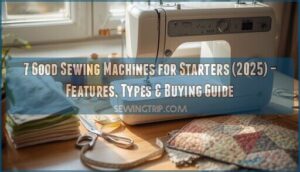
Threading a needle shouldn’t feel like solving a puzzle with missing pieces. For beginners, even winding a bobbin can tie your patience in knots. You might picture sewing as a craft for the patient or naturally gifted, but the right machine does half the heavy lifting.
With clever features like drop-in bobbins and automatic needle threaders, a good sewing machine for starters replaces frustration with small victories.
The choices in 2025 reach far beyond the clunky tools of decades past, making it easier than ever to jump from your first straight stitch to a handmade gift worth keeping around.
Table Of Contents
Key Takeaways
- Look for machines with drop-in bobbins, automatic needle threaders, and adjustable speed control—these features cut frustration and help you focus on learning instead of wrestling with setup.
- Most beginners need only 10–15 built-in stitches (straight, zigzag, stretch, and utility stitches) to handle nearly every project, so don’t get distracted by machines boasting hundreds of decorative options you won’t use.
- Budget $180–$250 for a reliable, feature-rich starter machine from trusted brands like Brother, Singer, or Janome—cheaper models often lack durability, while pricier ones offer features you don’t need yet.
- Regular cleaning after each project and proper storage with dust covers in climate-controlled spaces will extend your machine’s life from 5 to 8 years, making maintenance habits as important as the machine itself.
Key Features in Beginner Sewing Machines
Picking your first sewing machine can feel like a big step, but the right features make all the difference. If you know what to look for, sewing quickly shifts from confusing to rewarding.
Choosing the right sewing machine transforms learning from a daunting task into an enjoyable, rewarding experience
Here are the key options that matter most when you’re just getting started.
Drop-in Bobbin and Easy Threading
If you’re stepping into sewing, an easy-to-use drop-in bobbin system makes a world of difference. Drop-in bobbins cut down on threading time, reduce jamming, and boost reliability. Paired with features like an automatic needle threader, they offer threading accessibility and satisfaction for beginners. Fewer maintenance interruptions and smooth starts mean you’ll spend more time actually sewing.
Understanding how to manage thread tension control is also key for successful sewing.
Adjustable Sewing Speed and Control
Being able to adjust your sewing speed offers more than just comfort—it’s a real boost for confidence as you build new skills. Whether you favor manual speed control with a foot pedal or enjoy digital settings, this feature aids safer, smoother sewing for beginners.
Speed control benefits you by letting you slow down for tricky patterns or move faster on long seams. Proper speed ensures quality stitching output for various projects.
Automatic Needle Threader Benefits
Reliable threading can make or break your momentum at the machine. With a beginner sewing machine that offers an automatic needle threader, you’ll enjoy real eye strain reduction and time savings.
This feature boosts ease of use, improves accessibility for all hands, and accommodates a wide range of needle types—so threading isn’t a hurdle, but a quick step forward.
Back Stitch and Buttonhole Options
Threading done, let’s talk seams and details. Nearly every starter machine lets you lock a seam with a back stitch, keeping projects sturdy and frustration-free. Buttonhole options vary—one-step buttonholes save time, four-step styles offer more customization. Look for:
- Backstitch Prevalence
- Buttonhole Types
- Ease of Use
- Selection Trends
- Customization Stats
Included Presser Feet and Accessories
A well-chosen beginner sewing machine should arrive with essential feet like zigzag and buttonhole styles—necessary for most beginner sewing projects. Accessory bundles usually include basics such as spare bobbins, a seam ripper, and lint brush.
Look for specialty feet and trending accessories in value bundles. These added sewing machine features can make learning easier and boost confidence from the start.
Types of Sewing Machines for Starters
When you start shopping for a sewing machine, you’ll find several types made for different projects and skill levels. Each one has its own way of making sewing easier or more creative.
Here’s a quick look at the main options you’ll see as a beginner.
Mechanical Vs. Computerized Models
If you’re weighing a mechanical sewing machine against a computerized one, start with your goals. Mechanical vs computerized machines split on Stitch Variety and Feature Automation—mechanical types offer basic stitches and hands-on Speed Control, while computerized sewing machines access hundreds of settings and built-in help.
Repair Complexity is lower with mechanical models, but computerized options have a gentler Learning Curve for total beginners.
Embroidery and Combination Machines
An entry-level embroidery machine or combination sewing and embroidery machine lets you explore everything from dense decorative stitches to designs made just for you right at home.
Most models for starters offer USB or Wi-Fi Design Transfer, fast Stitch Speed, 4”x4” to 5”x7” Field Size, and a hefty share of built-in embroidery designs—no surprise given rising Brand Share and market growth in 2025.
Quilting and Serger Machines for Beginners
Ever wondered why so many beginner quilters pause at the mention of sergers? The learning curve can feel steep, especially with Threading Challenges, but the right quilting machine setups tackle these head-on.
Look for handy features like:
- Simple color-coded threading
- Adjustable Serger Functions
- Built-in specialized Quilting Feet
- Market Trends favoring semi-automatic controls
- Accessory Kits packed with must-haves
Choosing wisely means quilting confidence, not frustration.
Top 7 Sewing Machines for Beginners
If you’re ready to start sewing, picking the right machine can make all the difference. Below, you’ll find seven great beginner-friendly models that balance ease of use, features, and value.
Take a look and see which one fits your needs best.
1. Brother CS7000X Sewing Quilting Machine
If you’re looking for a beginner sewing machine that feels more like a trusty sidekick than a tool, the Brother CS7000X is worth your focus. It pairs Stitch Capabilities—like 70 built-in stitches and seven buttonholes—with Beginner Friendliness through its jam-resistant drop-in bobbin and automatic needle threader.
The generous Accessory Package gives you quilting feet and a wide table, making large projects simple.
Strong Performance Data and positive Market Reception mean this sewing machine keeps pace, whether you’re sewing clothes or tackling quilting adventures.
Best For: Beginners and hobbyists who want an easy-to-use sewing and quilting machine with lots of built-in features and good accessory support.
- Wide range of stitches and accessories for different projects, including quilting and clothing.
- Beginner-friendly with jam-resistant bobbin, automatic needle threader, and easy speed control.
- Durable, lightweight, and gets high marks for reliability and value.
- Only works with 120V—using it internationally may void the warranty.
- Some users report occasional errors and tension issues.
- The automatic bobbin threader can be tricky for a few people to master.
2. KPCB Tech Beginner Sewing Machine Set
Think you need a big machine to start sewing? The KPCB Tech Beginner Sewing Machine Set proves otherwise. Its Portability Benefits make it a breeze to move and store, and the included 42-piece kit ensures strong Accessory Quality from day one.
You’ll notice its Beginner Durability holds up for light projects, though heavy fabrics reveal the Stitch Limitations typical of compact types of sewing machines.
For its price, Market Affordability stands out—ideal for exploring beginner sewing tips without breaking the bank.
Best For: Beginners, kids, or anyone who wants an easy, affordable sewing starter kit for light projects at home.
- Complete 42-piece accessory set and extension table make getting started simple.
- Ultra-lightweight and compact, so it’s easy to carry or store anywhere.
- Priced for tight budgets, often bundled with bonus fabric and safety finger guard.
- Struggles with heavy fabrics or thick seams—best for lighter materials only.
- Tension and stitch control are basic, which limits precision.
- Some users report occasional quality issues or small size feeling limiting.
3. Singer Portable Sewing Machine Kit
For beginners seeking a portable option, the Singer Portable Sewing Machine Kit offers true portability benefits without skimping on function. Stitch versatility comes from 57 built-in stitch applications—plenty for basic mending or creative projects—while included accessories like assorted thread, scissors, and presser feet set you up for success right out of the box.
User feedback consistently highlights how its lightweight build and easy-to-understand controls support beginner suitability, with many beginner sewing machine reviews praising its steady performance for everyday sewing needs.
Best For: Beginners, hobbyists, and anyone needing a lightweight, easy-to-carry sewing machine for quick fixes and small projects.
- Portable and cordless design makes it simple to take anywhere.
- Comes with a full starter kit and built-in storage for easy organization.
- Straightforward controls and preset settings make learning to sew less intimidating.
- Not intended for heavy-duty fabrics or commercial use.
- Some users report occasional threading and jamming issues.
- May slide on smooth surfaces and requires batteries that need frequent replacement.
4. Brother Computerized Sewing Machine
If you’re weighing convenience against capability, a Brother Computerized Sewing Machine hits the sweet spot. With automated features like automatic needle threading, adjustable sewing speed, and a top drop-in bobbin, tasks that once slowed down beginners—like the Brother Sewing Machine XM2701—now feel simple.
User satisfaction runs high, with customer reviews often spotlighting reliability and easy-to-grasp controls. Considering the price range, you get polished starter functions and the flexibility to grow, echoing strong sales trends for computerized sewing machines in 2025.
Best For: Beginner and intermediate sewists who want intuitive features and versatility for everyday projects, crafts, and quilting.
- Automatic needle threader, speed control, and LCD stitch selection make setup and sewing quick, even for new users.
- Wide selection of stitches and included presser feet support a variety of creative projects and sewing techniques.
- Reliable performance, strong customer satisfaction, and good value compared to other entry-level machines.
- Not suited for heavy-duty fabrics or high-volume industrial use.
- Some users find controls like the reverse button and needle change area awkward.
- Warranty is valid only in the US, so international buyers may not be covered.
5. Brother Sewing And Embroidery Machine
When you want more than the basics, a combination sewing and embroidery machine like the Brother Sewing And Embroidery Machine offers plenty of room to grow. The color LCD touchscreen means you can preview and edit right on the machine, while built-in Design Transfer and wireless connectivity lighten the load for beginner projects.
Compared to a Brother Sewing Machine XM2701 or the Brother Sewing and Quilting Machine CS6000i, you get combination benefits without giving up easy maintenance needs or the straightforward sewing machine features that make learning so approachable.
Best For: Beginners and hobbyists who want both sewing and embroidery features in an easy-to-use, tech-friendly machine.
- Large color touchscreen makes editing and previewing designs simple and clear.
- Wireless connectivity and app support let you import or create custom patterns right from your phone or computer.
- Jam-resistant, drop-in bobbin and auto needle threader help remove frustration for new users.
- 4″ x 4″ embroidery field may feel cramped for larger quilting or craft projects.
- Extra accessories and some advanced designs require separate purchases or a subscription.
- The machine’s size and weight can be a hassle if you need to move or store it often.
6. Singer 7258 Sewing and Quilting Machine
Looking for balanced stitch functionality and ease? The Singer 7258 sewing and quilting machine stands out for its automation features, with push-button stitch selection and an automatic needle threader that save you time.
You’ll spot included accessories—ten presser feet, an accessory kit, and a hard cover—that expand your project options.
This sturdy, beginner sewing machine wins recognition for its reliable durability, smooth sewing machine performance, and positive reviews across sewing machine brands. Awards spotlight its value, but the everyday use is what truly impresses.
Best For: Beginners and intermediate sewists who want a user-friendly machine with a wide range of stitches and reliable automation features.
- Intuitive push-button controls and automation make sewing setup fast and easy.
- Comes with 10 presser feet, accessory kit, and hard cover for versatility and value.
- Highly rated for reliability, durability, and stitch quality on various fabrics.
- Plastic components may wear out with heavy use over time.
- Not designed for industrial or heavy-duty professional sewing.
- Some users report occasional issues with power source compatibility and missing manuals.
7. NEX Portable Sewing Machine For Kids
Child Safety and simplicity sit at the heart of the NEX Portable Sewing Machine For Kids. Weighing just about five pounds and comfortably fitting small hands, this beginner sewing machine offers 12 stitch capabilities, bright LED lighting, and clear speed controls for guided learning.
For young makers, portability means crafting at a friend’s house or stowing it away after projects. It’s budget-friendly, beginner-friendly, and just right for light fabrics, though patience is needed for threading and setup—like every gentle step on a learning curve.
Best For: Young beginners and kids (ages 8+) who want an easy, portable way to learn basic sewing skills and tackle small, fun projects.
- Lightweight, compact, and simple for kids to handle and store
- Offers 12 stitch patterns and slow speed control for safer, guided learning
- Budget-friendly price makes it accessible for families and gifting
- Struggles with thicker or heavy fabrics and may tangle bobbin thread
- No reverse sewing; reinforcement requires manual fabric rotation
- Foot pedal and threading setup can be tricky for smaller hands
How to Choose The Right Starter Machine
Picking your first sewing machine can feel overwhelming, but a few key details make the decision much simpler. The right fit depends on what matters most to you, from features to value.
Here’s what to think about as you compare options.
Number of Stitches and Stitch Functions
Have you ever noticed how most sewing projects start and finish with just a few essential stitch types? For beginners, a machine offering 10–15 built-in stitches, including straight, zigzag, stretch stitch, and utility stitches, covers nearly every need.
Decorative stitches add creative value, but adjustability importance and stretch stitch necessity often outweigh the appeal of a long stitch selection.
Ease of Use and Beginner-Friendly Design
Simplicity is your strongest ally when starting out with a beginner sewing machine. Straightforward Design and Simplified Controls make learning less intimidating, smoothing out the learning curve.
Ergonomics matter—easy-to-use dials and clearly labeled buttons help you focus on sewing for beginners.
A thorough User Manual is essential, turning a beginner-friendly machine into a reassuring introduction to new features and confident stitching.
Portability, Size, and Weight
Finding a beginner sewing machine that fits your lifestyle is like picking the right travel bag—it shouldn’t weigh you down. Most portable, beginner-friendly models weigh between 10–13 lbs and boast compact dimensions and built-in carrying options.
These travel machines tuck easily into closets or shelves, keeping your storage footprint small and your sewing ambitions on the move.
Price Range and Value for Money
Think of buying a sewing machine like buying a kitchen workhorse—you want value that lasts. Entry-level sewing machines now start around $100, but $180–$250 often buys a more reliable, feature-rich model.
Budget Considerations matter, but Feature Prioritization and Long-Term Savings set you up for years of confident sewing, thanks to positive Market Trends and solid Cost-Benefit balance.
Brand Reputation and Customer Reviews
Brand reliability isn’t just marketing—it’s backed by real user experiences and years of industry review analysis. Brother, Singer, and Janome consistently earn positive marks in sewing machine reviews for starters.
When buying a sewing machine, pay attention to model comparisons and satisfaction trends—testing sewing machines has shown that these sewing machine brands stand out for dependable performance and long-term value.
Maintenance Tips for Beginner Sewing Machines
Taking care of your sewing machine right from the start makes everything run smoother. Good habits also help your projects turn out better, and fewer surprises crop up along the way.
Here are a few simple ways to keep your machine in good shape.
Regular Cleaning and Oiling
Regularly cleaning your machine keeps lint buildup from sabotaging your stitches and extends its life. After each project, brush debris from the bobbin area and feed dogs using the cleaning tools from your instruction manual.
Check your maintenance schedule for proper oiling frequency—just a drop at each spot. These simple habits make troubleshooting and threading easier and protect your investment’s longevity.
Proper Storage and Dust Protection
Once you finish cleaning, protect your sewing machine from the impact of dust and humidity. Use dust covers between projects and store your machine in climate-controlled spaces for best results. Try these habits for long-term sewing machine maintenance:
- Use fitted dust covers
- Store in climate-controlled areas
- Stack in padded portable cases
- Choose storage containers wisely
- Check your instruction manual for care tips
Troubleshooting Common Issues
Even with a jam-resistant machine, a little troubleshooting smooths things out. Most thread jamming and skipped stitches happen after threading mistakes or human error, so retrace your steps—lift the presser foot and rethread both upper and bobbin threads.
If fabric feeding stalls or you spot thread breakage, check for lint, switch needles, and use your instruction manual for quick fixes.
Accessing Instruction Manuals and Guides
If fixing jams leaves you guessing, your instruction manual or quick-start guide is your best sidekick—most new sewing machines come with both physical and digital manuals. Lost yours? Manufacturer support teams respond quickly to manual requests, and third-party guides fill gaps for discontinued models.
For visual learners, look for video instructions and interactive guide formats online.
Frequently Asked Questions (FAQs)
What fabric types work best for beginners?
Cotton ease makes it the top choice—89% of instructors recommend it. Linen benefits include shape retention, while chambray denim offers structure. Muslin practice builds confidence, and flannel comfort minimizes fraying for beginner projects.
Can I sew thick denim on starter machines?
You’ll need a machine with at least 0-amp motor power and denim needle types like 100/16.
The Singer Heavy Duty 4423 works with heavy fabrics well, but seam thickness limits matter—speed control importance increases with multiple layers.
How long do beginner sewing machines typically last?
Most beginner sewing machines last 5 to 8 years with regular use. Durability and build quality, maintenance habits, and usage frequency all affect lifespan.
Metal machines generally outlast plastic models, with proper care extending longevity considerably.
Should I take sewing classes before buying a machine?
It sounds extreme, but sewing lessons can prevent most beginner regret.
Classes boost confidence by 67%, reduce frustration, and sharpen feature awareness—helping you choose wisely and avoid costly mistakes before investing in your first machine.
Whats the difference between needles for different projects?
Different needle point types affect fabric compatibility and project outcomes. Universal needles work for most sewing projects, while ballpoint needles suit knits.
Consider needle lifespan and coating durability as accessories for your sewing machine.
Conclusion
Think of your first machine as a sturdy pair of training wheels—it won’t do the pedaling for you, but it keeps you upright while you build confidence. A good sewing machine for starters turns clumsy attempts into clean seams, one project at a time.
Pick features that simplify the learning curve, maintain your tool with care, and give yourself permission to make wobbly stitches. Mastery starts with showing up, not flawlessness.
- https://www.reddit.com/r/SewingForBeginners/comments/18s4yss/what_is_the_best_sewing_machine_for_a_total/
- https://www.gloryallan.com/blogs/news/the-best-beginner-sewing-machine-your-ultimate-guide-2024
- https://sewcanshe.com/7-best-sewing-machines-for-a-beginner/
- https://www.techgearlab.com/topics/electronics/best-sewing-machine
- https://www.applegreencottage.com/best-sewing-machine-for-beginners/

